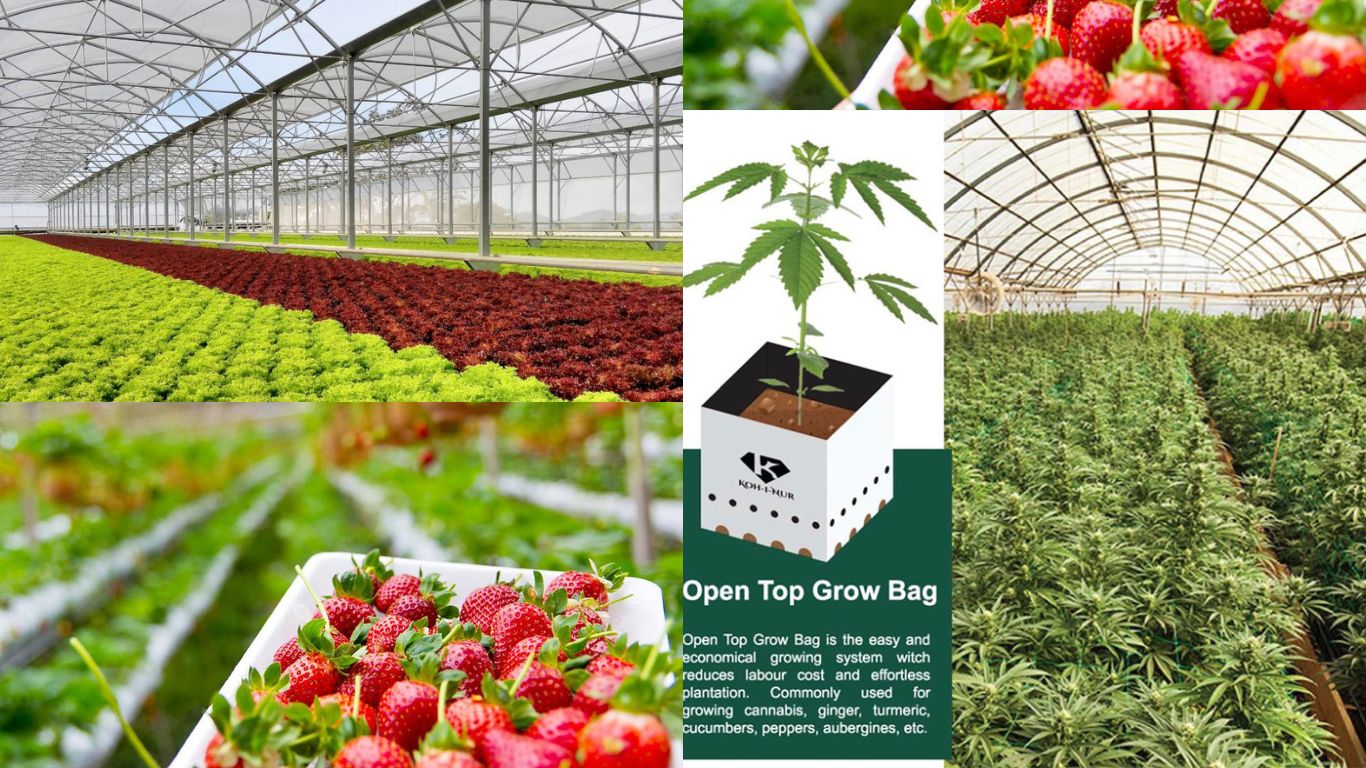
Greenhouse gardening with coco coir refers to the practice of using coco coir as a growing medium in a greenhouse environment. Coco coir, derived from coconut husks, is a popular choice for greenhouse gardening due to its excellent water retention, aeration, and nutrient-holding properties. EVERAN’s open OPEN TOP GROW BAG gives huge Support to those who are willing in greenhouse gardening. Here’s an overview of greenhouse gardening with coco coir and its benefits:
-
Growing Medium: Coco coir serves as an ideal alternative to traditional soil in greenhouse gardening. Its fibrous structure provides excellent aeration, allowing roots to access oxygen easily. It retains moisture well, providing plants with a consistent water supply and reducing the frequency of watering. Coco coir also has good nutrient-holding capacity, ensuring that plants have access to essential nutrients for healthy growth.
-
Water Efficiency: Greenhouse gardening with coco coir promotes water efficiency. Coco coir has a high water retention capacity, meaning it can hold onto moisture for longer periods. This reduces the need for frequent watering, conserves water, and helps maintain a consistent level of soil moisture critical for plant growth.
-
Nutrient Availability: Coco coir can be enriched with nutrients to support plant growth in a greenhouse environment. It has the ability to retain and release nutrients gradually, ensuring a steady supply of essential elements to the plants. This allows for precise control over nutrient levels, resulting in healthier and more productive crops.
-
pH Stability: Coco coir has a neutral pH, providing a stable and balanced growing environment for greenhouse plants. It reduces the need for pH adjustments, making it easier to maintain optimal pH levels for specific crops. The stable pH range of coco coir helps facilitate nutrient uptake by plants.
-
Disease Resistance: Coco coir has natural antifungal and antibacterial properties, reducing the risk of soil-borne diseases in greenhouse gardening. This is particularly beneficial in a controlled environment like a greenhouse, where disease prevention and management are crucial for successful crop production.
-
Versatility: Greenhouse gardening with coco coir is suitable for a wide range of plants, including vegetables, herbs, flowers, and even exotic or tropical species. Whether you’re growing tomatoes, cucumbers, herbs, or ornamental plants, coco coir provides an adaptable and supportive growing medium.
-
Sustainability: Coco coir is an environmentally friendly choice for greenhouse gardening. It is a renewable resource made from coconut husks, a byproduct of the coconut industry. Using coco coir as a growing medium reduces the dependence on traditional soil, which may be depleted or environmentally compromised.
By utilizing coco coir in greenhouse gardening, you can optimize water usage, provide a balanced nutrient environment, enhance disease resistance, and promote sustainable cultivation practices. These benefits make greenhouse gardening with coco coir an effective and efficient method for growing a variety of plants in a controlled and productive environment.
STEPS FOR START GREEN HOUSE GARDENING Using EVERAN’s COCO COIR OR COCO Peat
Using COCO COIR in greenhouse gardening involves several steps to ensure successful plant growth. Here’s a general guide on how to use coco coir in greenhouse gardening:
-
Prepare the Growing Containers: Select appropriate containers for your greenhouse plants, such as pots, trays, or grow bags. Ensure the containers have drainage holes to prevent waterlogging. Clean and sanitize the containers before use to minimize the risk of disease.
-
Rehydrate the Coco Coir: Coco coir usually comes in a dehydrated form. Follow the manufacturer’s instructions to rehydrate the coco coir blocks or bricks. Typically, you will need to soak them in water until they expand and become fluffy. Drain off any excess water.
-
Mix with Amendments (Optional): Coco coir alone provides a good growing medium, but you can enhance its nutrient content by adding amendments. This may include compost, perlite, vermiculite, or organic fertilizers. Thoroughly mix the amendments with the rehydrated coco coir to ensure a well-balanced growing medium.
-
Fill the Containers: Fill the prepared containers with the coco coir mixture. Gently press the coir down to create a firm but not compacted planting medium. Leave some space at the top of the container to allow for watering and root growth.
-
Planting: Plant your seeds or seedlings in the coco coir-filled containers according to the specific requirements of the plant species. Make sure to provide adequate spacing between plants to allow for proper growth and airflow.
-
Watering: Coco coir retains moisture well, but it’s important to maintain proper moisture levels. Water the plants regularly, ensuring that the coco coir stays evenly moist but not waterlogged. Monitor the moisture levels by checking the top layer of the coir and adjusting watering frequency accordingly.
-
Nutrient Management: Coco coir acts as a neutral medium, so you will need to provide nutrients to the plants. This can be done through regular fertilization using a balanced liquid fertilizer or by incorporating slow-release fertilizers into the coco coir mixture. Follow the specific fertilizer instructions and monitor plant growth for any signs of nutrient deficiencies or excesses.
-
Environmental Control: Greenhouses offer controlled environments, allowing you to manage temperature, humidity, and ventilation. Monitor and adjust these factors according to the needs of your plants. Coco coir provides good insulation and aeration, contributing to a healthy root environment.
-
Maintenance and Care: Regularly inspect your greenhouse plants for pests, diseases, and weeds. Address any issues promptly to prevent damage. Prune and train plants as needed to maintain desired growth and shape.
-
Harvesting: Depending on the type of plants you are growing, follow the appropriate harvesting guidelines for each crop. Enjoy the fruits (or vegetables or flowers) of your greenhouse gardening efforts!
Remember to refer to specific plant requirements and adjust your greenhouse management practices accordingly. Each plant species may have unique needs in terms of light, temperature, humidity, and watering. By combining the benefits of greenhouse gardening and coco coir as a growing medium, you can create a productive and thriving environment for your plants.
